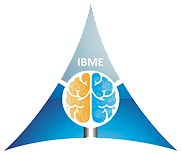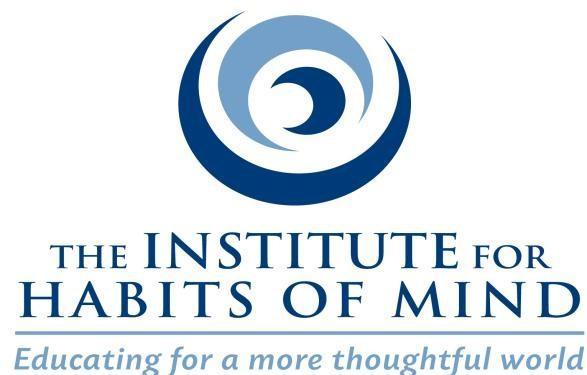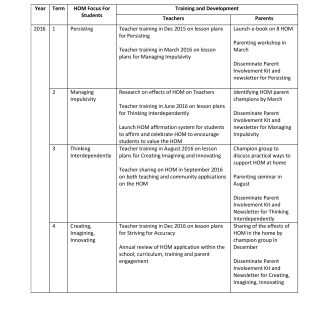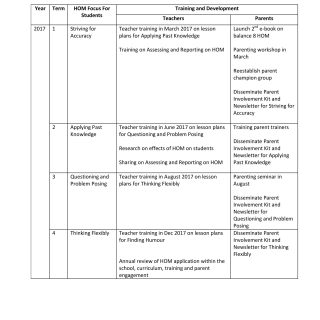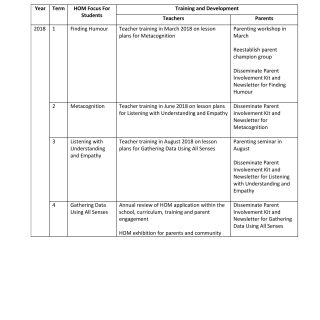THE PROCESS OF BECOMING:
This award is not intended for those new to the HOM. Rather, each aspiring school will be expected to have developed, embedded and sustained the Habits of Mind for a sufficient period of time to realize the benefits of the Habits of Mind and to make a commitment to expand, deepen, and learn more about the power of the Habits of Mind.
If you are interested in having your school become an IHOM Learning Community, you are invited to contact [email protected].
IHOM Certification fees: Prior to certification, an on site visit by an IHOM representative/Affiliate Director to guide, support and assist. The cost will not exceed USD$2500.00 plus travel expenses. This fee and visit can be waived if the school has actively been engaged with the IHOM, including an on site visit with the year prior to certification.
IHOM Certification fees: USD$1000.00 good for 3 years and renewable with review.
THE PROCESS OF DOCUMENTATION
Envisioning a Habits of Mind Learning Community
Staff and school community reviews the vision of the Habits of Mind Learning Community in Appendix C of the book, Learning and Leading with Habits of Mind. It is included below as a resource in developing and creating a three year plan to mark progress and most importantly envision the future growth and development in HOM.
The staff self-assesses where they are now in the journey toward their vision and what the staff hopes to accomplish over the next three years in achieving their vision. A short and long-range continuous growth plan of action including benchmarks and timelines would be developed to move the staff and community toward that vision. The document should be endorsed by staff members and the extended school community. The outcome of this step is a 3-year action plan. The school is encouraged to capture the history with HOM and map out the three year continuous growth in a way that represents the spirit of the school. IHOM encourages creating, imagining and innovating during this process.
GUIDANCE FOR DEVELOPING A PROPOSAL FOR CERTIFICATION
We are often asked, “How would you know when and if the Habits of Mind have been infused?” We usually respond by saying that we’d know it when there is a “harmony of heart and mind”: when it is mindfully infused throughout the curriculum, instructional practices, assessment strategies, the people in and the culture of the schools– not just a Habits of Mind school but truly a “mindful school” dedicated to improving society. There is implementation fidelity in evidence. Furthermore, we believe this is never-ending journey towards infusion rather than a status to be achieved. It becomes a “way of being” rather than a “thing to do.” Those are pretty general statements.
As you answer these questions, you will be thinking at two levels:
1. What are we already doing?
2. What would we like to do over the next 3 years to strengthen our school’s commitment to the Habits of Mind?
Answering those two questions will form your proposal for certification. If you like, the Institute can provide coaching, consultation, and support throughout the process. We have many skillful educators who can work with you.
The following are categories we defined to help with your thinking. You may come up with some new categories. Please feel free to be innovative with this form.
1. All the inhabitants of the school
• In what ways are the staff, students, and parents:
• Using the Habits of Mind language in their communications?
• Finding new ways to expand the Habits of Mind in a variety of settings?
• Valuing the Habits of Mind for all of the members of the learning community?
2. Classroom Instruction
• In what ways are the classrooms:
• Teaching the Habits of Mind intentionally?
• Focusing on being alert to situation in which the Habits of Mind can be practiced, valued, illuminated, and reflected upon?
• Use tools and resources to deepen understanding of the Habits of Mind?
3. Curriculum Design
• In what ways is curriculum designed to:
• Weave Habits of Mind into units and lessons?
• Build a thorough line of how Habits of Mind develop over multiple years?
• Include the Habits of Mind as stated goals and outcomes for students?
4. School Culture
• In what ways are the Habits of Mind:
• Recognized when they are performed?
• Recognized in the environment with signs and signals such as posters, slogans, etc.?
5. Parents and Community
• In what ways are parents and community:
• Continuously informed about their student’s progress with HOM?
• Oriented to the vision of the school and the meaning and commitment to HOM?
6. Action Research
• In what ways does the school:
• Inform their practices with HOM?
• Collect evidence of longitudinal growth?
• Continue their study of the Habits of Mind?
• Communicate with others as they learn more about the HOM?
7. Leading Learning
• In what ways does the school:
• Distribute leadership among staff members so that they are supporting and championing the HOM?
• Provide resources such as time, opportunities for collaboration, and finances to support their vision?
• Expect all leaders to model the HOM?
Based on (Appendix C, in Costa, A and Kallick, B. (2009) Learning and Leading with Habits of Mind 16 Characteristics of Success. Alexandria, VA: Association for Supervision and Curriculum Development.
